Entrepreneurial Orientation: Forrest's Approach to Entrepreneurship
VerifiedAdded on 2019/11/25
|14
|3770
|187
Essay
AI Summary
The entrepreneur decides to engage in a process that reaches its end when it succeeds in creating a new market. Forrest, considered an outspoken critic of governmental regulations and red tape, overcomes many obstacles to become a successful entrepreneur.
Contribute Materials
Your contribution can guide someone’s learning journey. Share your
documents today.
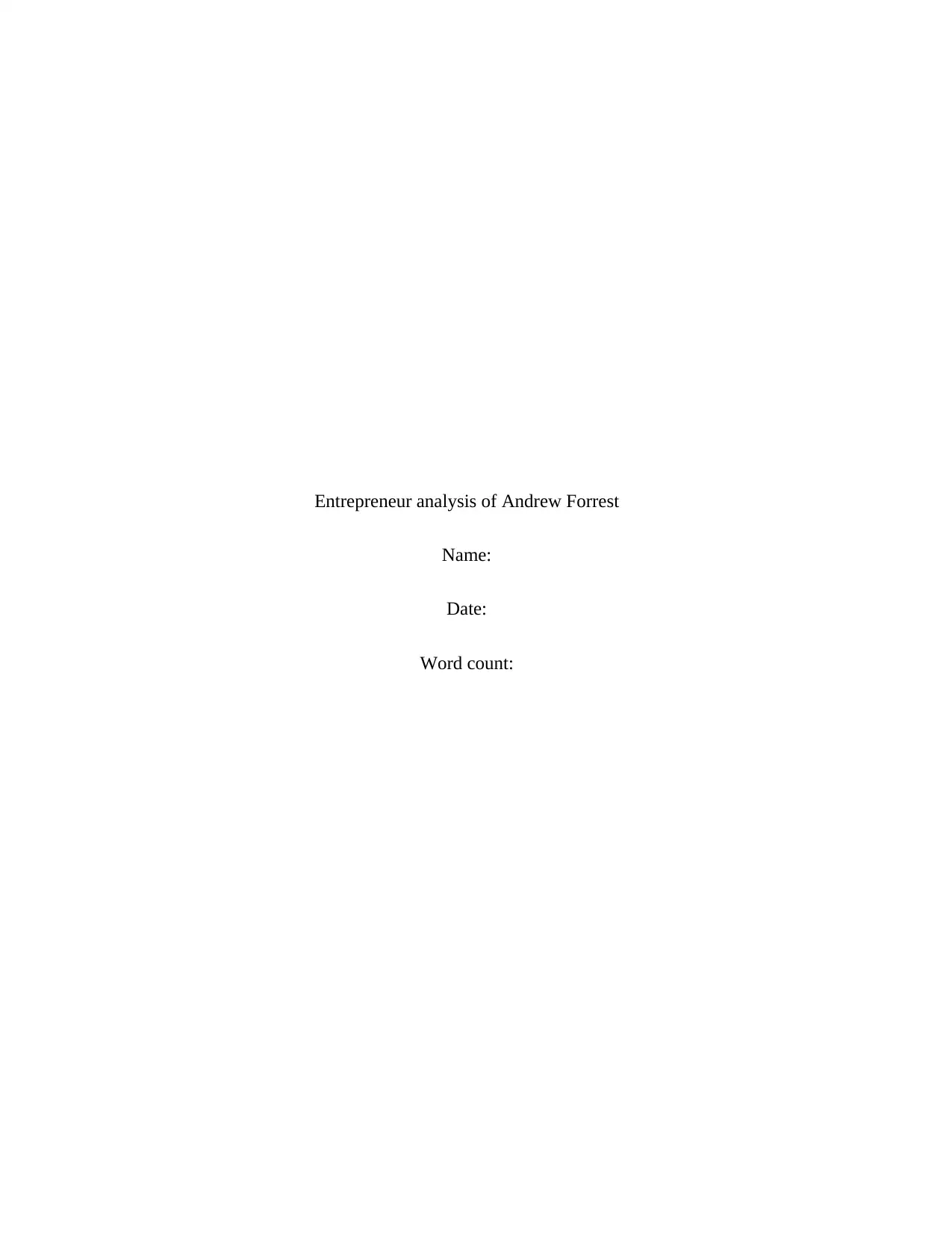
Entrepreneur analysis of Andrew Forrest
Name:
Date:
Word count:
Name:
Date:
Word count:
Secure Best Marks with AI Grader
Need help grading? Try our AI Grader for instant feedback on your assignments.
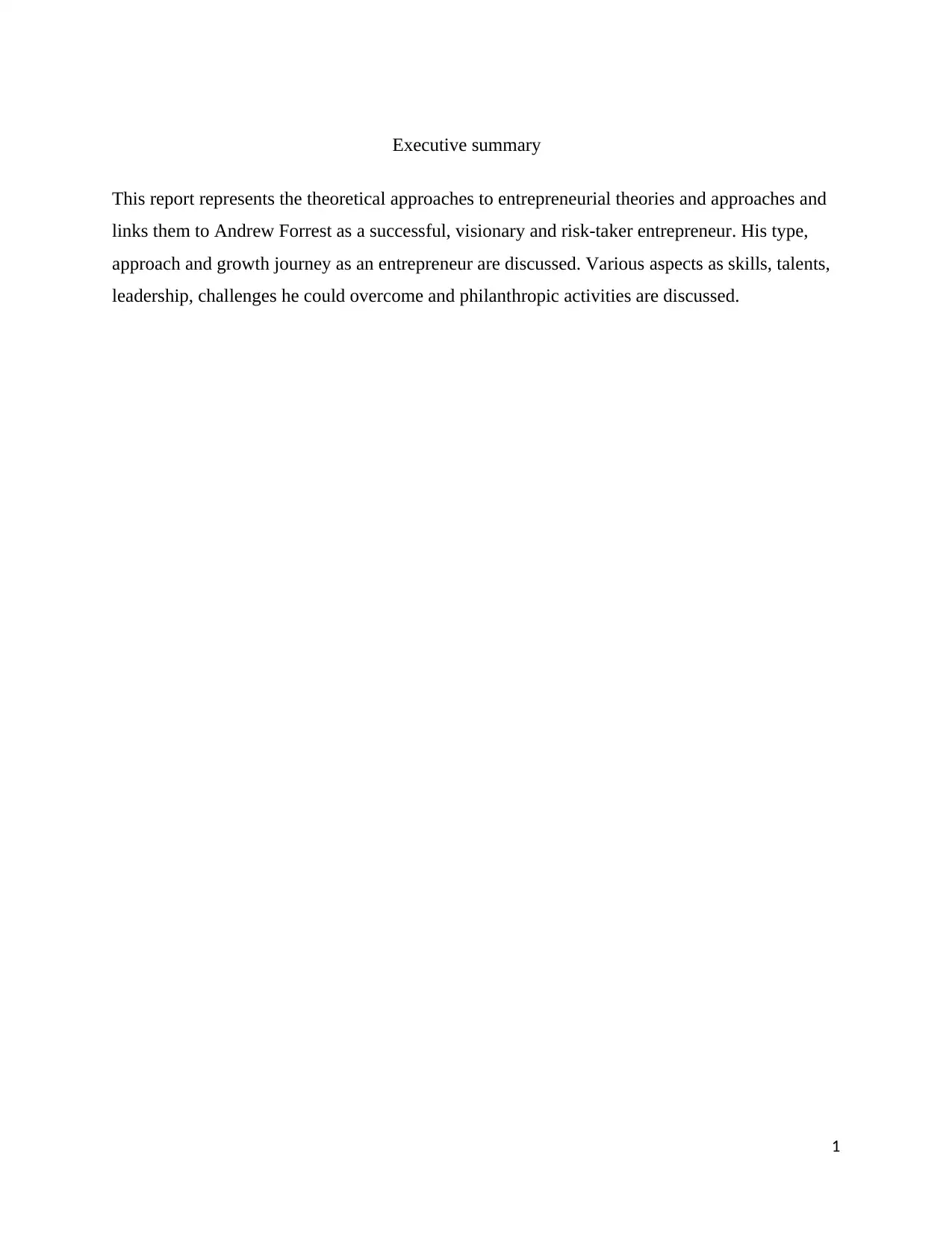
Executive summary
This report represents the theoretical approaches to entrepreneurial theories and approaches and
links them to Andrew Forrest as a successful, visionary and risk-taker entrepreneur. His type,
approach and growth journey as an entrepreneur are discussed. Various aspects as skills, talents,
leadership, challenges he could overcome and philanthropic activities are discussed.
1
This report represents the theoretical approaches to entrepreneurial theories and approaches and
links them to Andrew Forrest as a successful, visionary and risk-taker entrepreneur. His type,
approach and growth journey as an entrepreneur are discussed. Various aspects as skills, talents,
leadership, challenges he could overcome and philanthropic activities are discussed.
1
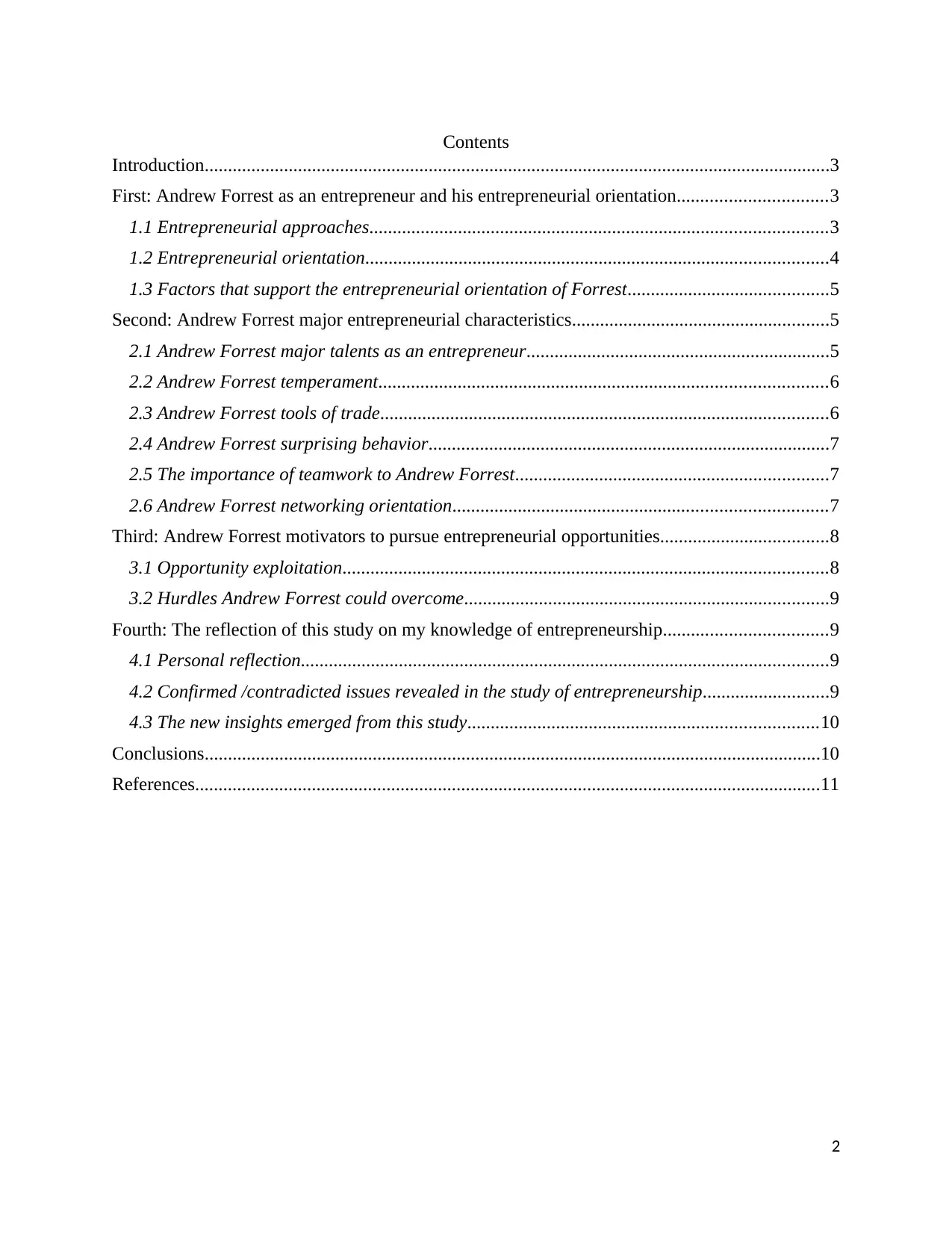
Contents
Introduction......................................................................................................................................3
First: Andrew Forrest as an entrepreneur and his entrepreneurial orientation................................3
1.1 Entrepreneurial approaches..................................................................................................3
1.2 Entrepreneurial orientation...................................................................................................4
1.3 Factors that support the entrepreneurial orientation of Forrest...........................................5
Second: Andrew Forrest major entrepreneurial characteristics.......................................................5
2.1 Andrew Forrest major talents as an entrepreneur.................................................................5
2.2 Andrew Forrest temperament................................................................................................6
2.3 Andrew Forrest tools of trade................................................................................................6
2.4 Andrew Forrest surprising behavior......................................................................................7
2.5 The importance of teamwork to Andrew Forrest...................................................................7
2.6 Andrew Forrest networking orientation................................................................................7
Third: Andrew Forrest motivators to pursue entrepreneurial opportunities....................................8
3.1 Opportunity exploitation........................................................................................................8
3.2 Hurdles Andrew Forrest could overcome..............................................................................9
Fourth: The reflection of this study on my knowledge of entrepreneurship...................................9
4.1 Personal reflection.................................................................................................................9
4.2 Confirmed /contradicted issues revealed in the study of entrepreneurship...........................9
4.3 The new insights emerged from this study...........................................................................10
Conclusions....................................................................................................................................10
References......................................................................................................................................11
2
Introduction......................................................................................................................................3
First: Andrew Forrest as an entrepreneur and his entrepreneurial orientation................................3
1.1 Entrepreneurial approaches..................................................................................................3
1.2 Entrepreneurial orientation...................................................................................................4
1.3 Factors that support the entrepreneurial orientation of Forrest...........................................5
Second: Andrew Forrest major entrepreneurial characteristics.......................................................5
2.1 Andrew Forrest major talents as an entrepreneur.................................................................5
2.2 Andrew Forrest temperament................................................................................................6
2.3 Andrew Forrest tools of trade................................................................................................6
2.4 Andrew Forrest surprising behavior......................................................................................7
2.5 The importance of teamwork to Andrew Forrest...................................................................7
2.6 Andrew Forrest networking orientation................................................................................7
Third: Andrew Forrest motivators to pursue entrepreneurial opportunities....................................8
3.1 Opportunity exploitation........................................................................................................8
3.2 Hurdles Andrew Forrest could overcome..............................................................................9
Fourth: The reflection of this study on my knowledge of entrepreneurship...................................9
4.1 Personal reflection.................................................................................................................9
4.2 Confirmed /contradicted issues revealed in the study of entrepreneurship...........................9
4.3 The new insights emerged from this study...........................................................................10
Conclusions....................................................................................................................................10
References......................................................................................................................................11
2
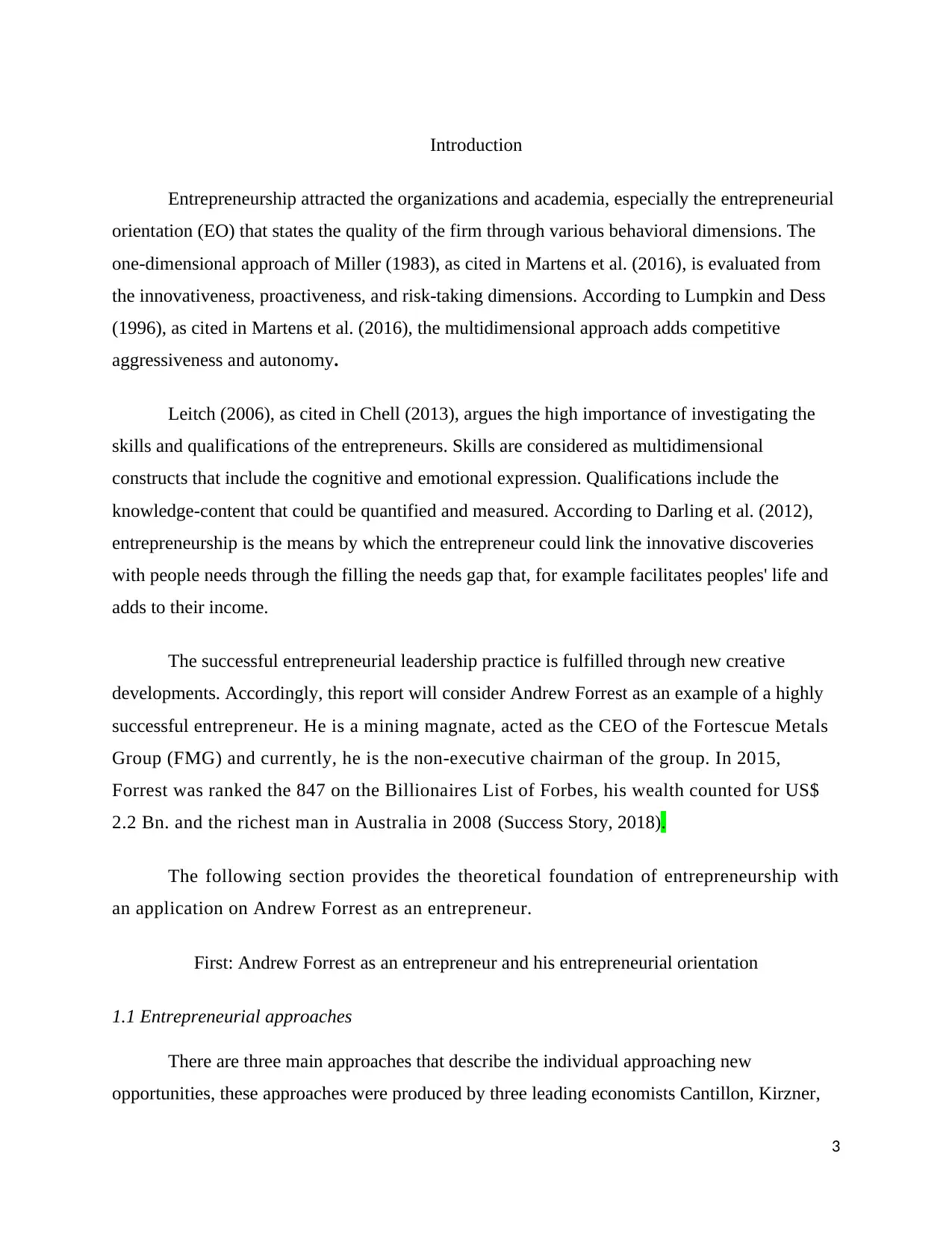
Introduction
Entrepreneurship attracted the organizations and academia, especially the entrepreneurial
orientation (EO) that states the quality of the firm through various behavioral dimensions. The
one-dimensional approach of Miller (1983), as cited in Martens et al. (2016), is evaluated from
the innovativeness, proactiveness, and risk-taking dimensions. According to Lumpkin and Dess
(1996), as cited in Martens et al. (2016), the multidimensional approach adds competitive
aggressiveness and autonomy.
Leitch (2006), as cited in Chell (2013), argues the high importance of investigating the
skills and qualifications of the entrepreneurs. Skills are considered as multidimensional
constructs that include the cognitive and emotional expression. Qualifications include the
knowledge-content that could be quantified and measured. According to Darling et al. (2012),
entrepreneurship is the means by which the entrepreneur could link the innovative discoveries
with people needs through the filling the needs gap that, for example facilitates peoples' life and
adds to their income.
The successful entrepreneurial leadership practice is fulfilled through new creative
developments. Accordingly, this report will consider Andrew Forrest as an example of a highly
successful entrepreneur. He is a mining magnate, acted as the CEO of the Fortescue Metals
Group (FMG) and currently, he is the non-executive chairman of the group. In 2015,
Forrest was ranked the 847 on the Billionaires List of Forbes, his wealth counted for US$
2.2 Bn. and the richest man in Australia in 2008 (Success Story, 2018).
The following section provides the theoretical foundation of entrepreneurship with
an application on Andrew Forrest as an entrepreneur.
First: Andrew Forrest as an entrepreneur and his entrepreneurial orientation
1.1 Entrepreneurial approaches
There are three main approaches that describe the individual approaching new
opportunities, these approaches were produced by three leading economists Cantillon, Kirzner,
3
Entrepreneurship attracted the organizations and academia, especially the entrepreneurial
orientation (EO) that states the quality of the firm through various behavioral dimensions. The
one-dimensional approach of Miller (1983), as cited in Martens et al. (2016), is evaluated from
the innovativeness, proactiveness, and risk-taking dimensions. According to Lumpkin and Dess
(1996), as cited in Martens et al. (2016), the multidimensional approach adds competitive
aggressiveness and autonomy.
Leitch (2006), as cited in Chell (2013), argues the high importance of investigating the
skills and qualifications of the entrepreneurs. Skills are considered as multidimensional
constructs that include the cognitive and emotional expression. Qualifications include the
knowledge-content that could be quantified and measured. According to Darling et al. (2012),
entrepreneurship is the means by which the entrepreneur could link the innovative discoveries
with people needs through the filling the needs gap that, for example facilitates peoples' life and
adds to their income.
The successful entrepreneurial leadership practice is fulfilled through new creative
developments. Accordingly, this report will consider Andrew Forrest as an example of a highly
successful entrepreneur. He is a mining magnate, acted as the CEO of the Fortescue Metals
Group (FMG) and currently, he is the non-executive chairman of the group. In 2015,
Forrest was ranked the 847 on the Billionaires List of Forbes, his wealth counted for US$
2.2 Bn. and the richest man in Australia in 2008 (Success Story, 2018).
The following section provides the theoretical foundation of entrepreneurship with
an application on Andrew Forrest as an entrepreneur.
First: Andrew Forrest as an entrepreneur and his entrepreneurial orientation
1.1 Entrepreneurial approaches
There are three main approaches that describe the individual approaching new
opportunities, these approaches were produced by three leading economists Cantillon, Kirzner,
3
Secure Best Marks with AI Grader
Need help grading? Try our AI Grader for instant feedback on your assignments.
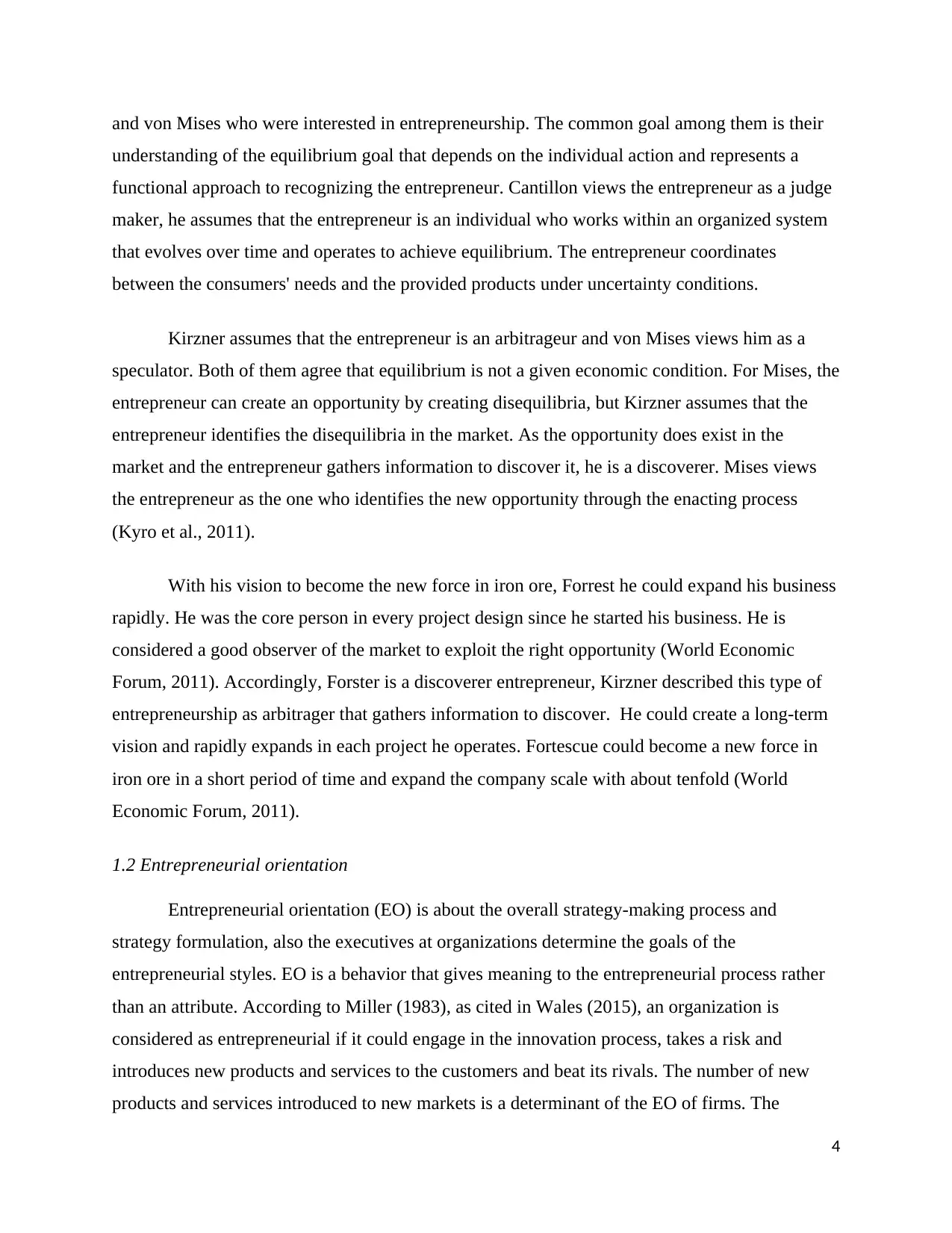
and von Mises who were interested in entrepreneurship. The common goal among them is their
understanding of the equilibrium goal that depends on the individual action and represents a
functional approach to recognizing the entrepreneur. Cantillon views the entrepreneur as a judge
maker, he assumes that the entrepreneur is an individual who works within an organized system
that evolves over time and operates to achieve equilibrium. The entrepreneur coordinates
between the consumers' needs and the provided products under uncertainty conditions.
Kirzner assumes that the entrepreneur is an arbitrageur and von Mises views him as a
speculator. Both of them agree that equilibrium is not a given economic condition. For Mises, the
entrepreneur can create an opportunity by creating disequilibria, but Kirzner assumes that the
entrepreneur identifies the disequilibria in the market. As the opportunity does exist in the
market and the entrepreneur gathers information to discover it, he is a discoverer. Mises views
the entrepreneur as the one who identifies the new opportunity through the enacting process
(Kyro et al., 2011).
With his vision to become the new force in iron ore, Forrest he could expand his business
rapidly. He was the core person in every project design since he started his business. He is
considered a good observer of the market to exploit the right opportunity (World Economic
Forum, 2011). Accordingly, Forster is a discoverer entrepreneur, Kirzner described this type of
entrepreneurship as arbitrager that gathers information to discover. He could create a long-term
vision and rapidly expands in each project he operates. Fortescue could become a new force in
iron ore in a short period of time and expand the company scale with about tenfold (World
Economic Forum, 2011).
1.2 Entrepreneurial orientation
Entrepreneurial orientation (EO) is about the overall strategy-making process and
strategy formulation, also the executives at organizations determine the goals of the
entrepreneurial styles. EO is a behavior that gives meaning to the entrepreneurial process rather
than an attribute. According to Miller (1983), as cited in Wales (2015), an organization is
considered as entrepreneurial if it could engage in the innovation process, takes a risk and
introduces new products and services to the customers and beat its rivals. The number of new
products and services introduced to new markets is a determinant of the EO of firms. The
4
understanding of the equilibrium goal that depends on the individual action and represents a
functional approach to recognizing the entrepreneur. Cantillon views the entrepreneur as a judge
maker, he assumes that the entrepreneur is an individual who works within an organized system
that evolves over time and operates to achieve equilibrium. The entrepreneur coordinates
between the consumers' needs and the provided products under uncertainty conditions.
Kirzner assumes that the entrepreneur is an arbitrageur and von Mises views him as a
speculator. Both of them agree that equilibrium is not a given economic condition. For Mises, the
entrepreneur can create an opportunity by creating disequilibria, but Kirzner assumes that the
entrepreneur identifies the disequilibria in the market. As the opportunity does exist in the
market and the entrepreneur gathers information to discover it, he is a discoverer. Mises views
the entrepreneur as the one who identifies the new opportunity through the enacting process
(Kyro et al., 2011).
With his vision to become the new force in iron ore, Forrest he could expand his business
rapidly. He was the core person in every project design since he started his business. He is
considered a good observer of the market to exploit the right opportunity (World Economic
Forum, 2011). Accordingly, Forster is a discoverer entrepreneur, Kirzner described this type of
entrepreneurship as arbitrager that gathers information to discover. He could create a long-term
vision and rapidly expands in each project he operates. Fortescue could become a new force in
iron ore in a short period of time and expand the company scale with about tenfold (World
Economic Forum, 2011).
1.2 Entrepreneurial orientation
Entrepreneurial orientation (EO) is about the overall strategy-making process and
strategy formulation, also the executives at organizations determine the goals of the
entrepreneurial styles. EO is a behavior that gives meaning to the entrepreneurial process rather
than an attribute. According to Miller (1983), as cited in Wales (2015), an organization is
considered as entrepreneurial if it could engage in the innovation process, takes a risk and
introduces new products and services to the customers and beat its rivals. The number of new
products and services introduced to new markets is a determinant of the EO of firms. The
4
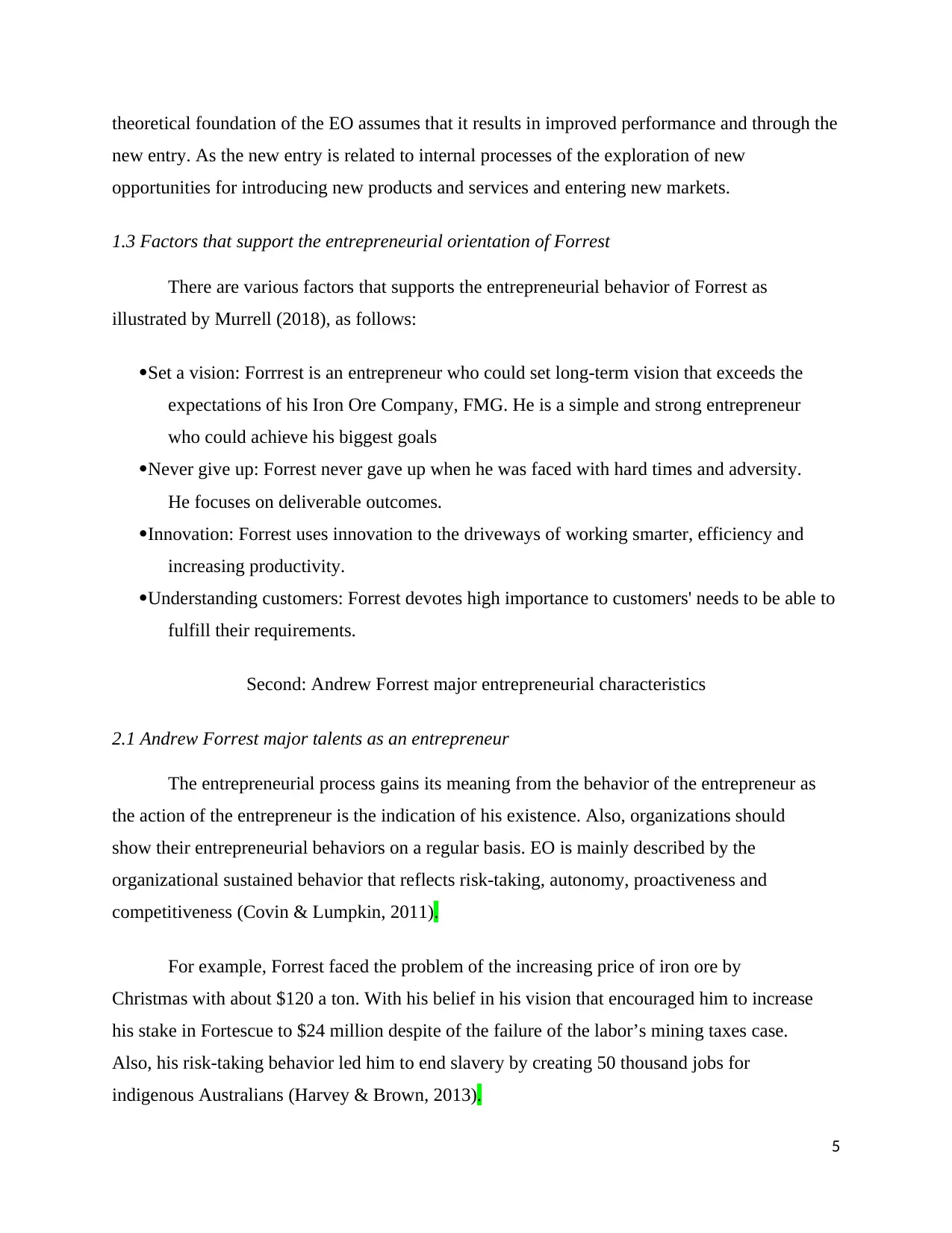
theoretical foundation of the EO assumes that it results in improved performance and through the
new entry. As the new entry is related to internal processes of the exploration of new
opportunities for introducing new products and services and entering new markets.
1.3 Factors that support the entrepreneurial orientation of Forrest
There are various factors that supports the entrepreneurial behavior of Forrest as
illustrated by Murrell (2018), as follows:
Set a vision: Forrrest is an entrepreneur who could set long-term vision that exceeds the
expectations of his Iron Ore Company, FMG. He is a simple and strong entrepreneur
who could achieve his biggest goals
Never give up: Forrest never gave up when he was faced with hard times and adversity.
He focuses on deliverable outcomes.
Innovation: Forrest uses innovation to the driveways of working smarter, efficiency and
increasing productivity.
Understanding customers: Forrest devotes high importance to customers' needs to be able to
fulfill their requirements.
Second: Andrew Forrest major entrepreneurial characteristics
2.1 Andrew Forrest major talents as an entrepreneur
The entrepreneurial process gains its meaning from the behavior of the entrepreneur as
the action of the entrepreneur is the indication of his existence. Also, organizations should
show their entrepreneurial behaviors on a regular basis. EO is mainly described by the
organizational sustained behavior that reflects risk-taking, autonomy, proactiveness and
competitiveness (Covin & Lumpkin, 2011).
For example, Forrest faced the problem of the increasing price of iron ore by
Christmas with about $120 a ton. With his belief in his vision that encouraged him to increase
his stake in Fortescue to $24 million despite of the failure of the labor’s mining taxes case.
Also, his risk-taking behavior led him to end slavery by creating 50 thousand jobs for
indigenous Australians (Harvey & Brown, 2013).
5
new entry. As the new entry is related to internal processes of the exploration of new
opportunities for introducing new products and services and entering new markets.
1.3 Factors that support the entrepreneurial orientation of Forrest
There are various factors that supports the entrepreneurial behavior of Forrest as
illustrated by Murrell (2018), as follows:
Set a vision: Forrrest is an entrepreneur who could set long-term vision that exceeds the
expectations of his Iron Ore Company, FMG. He is a simple and strong entrepreneur
who could achieve his biggest goals
Never give up: Forrest never gave up when he was faced with hard times and adversity.
He focuses on deliverable outcomes.
Innovation: Forrest uses innovation to the driveways of working smarter, efficiency and
increasing productivity.
Understanding customers: Forrest devotes high importance to customers' needs to be able to
fulfill their requirements.
Second: Andrew Forrest major entrepreneurial characteristics
2.1 Andrew Forrest major talents as an entrepreneur
The entrepreneurial process gains its meaning from the behavior of the entrepreneur as
the action of the entrepreneur is the indication of his existence. Also, organizations should
show their entrepreneurial behaviors on a regular basis. EO is mainly described by the
organizational sustained behavior that reflects risk-taking, autonomy, proactiveness and
competitiveness (Covin & Lumpkin, 2011).
For example, Forrest faced the problem of the increasing price of iron ore by
Christmas with about $120 a ton. With his belief in his vision that encouraged him to increase
his stake in Fortescue to $24 million despite of the failure of the labor’s mining taxes case.
Also, his risk-taking behavior led him to end slavery by creating 50 thousand jobs for
indigenous Australians (Harvey & Brown, 2013).
5
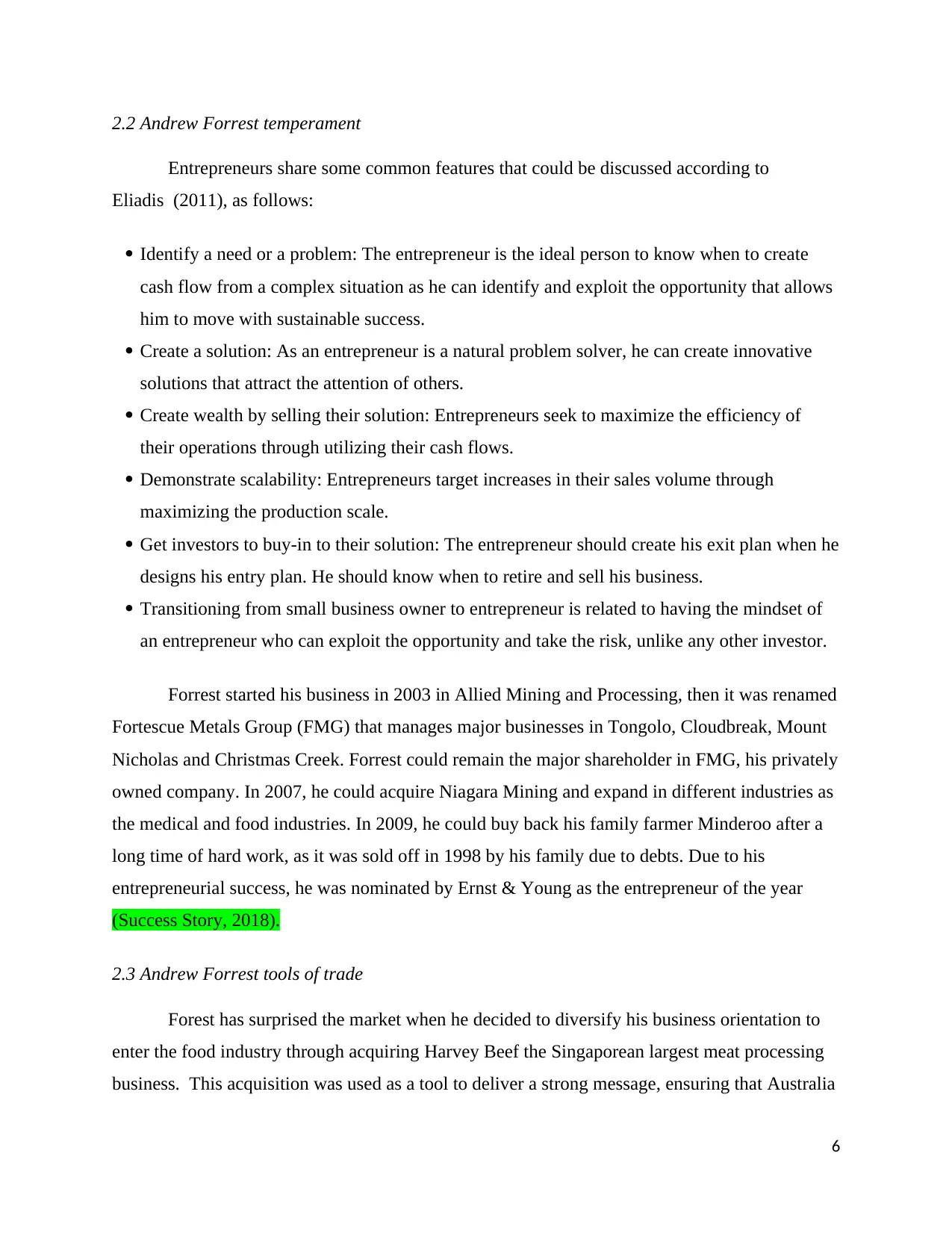
2.2 Andrew Forrest temperament
Entrepreneurs share some common features that could be discussed according to
Eliadis (2011), as follows:
Identify a need or a problem: The entrepreneur is the ideal person to know when to create
cash flow from a complex situation as he can identify and exploit the opportunity that allows
him to move with sustainable success.
Create a solution: As an entrepreneur is a natural problem solver, he can create innovative
solutions that attract the attention of others.
Create wealth by selling their solution: Entrepreneurs seek to maximize the efficiency of
their operations through utilizing their cash flows.
Demonstrate scalability: Entrepreneurs target increases in their sales volume through
maximizing the production scale.
Get investors to buy-in to their solution: The entrepreneur should create his exit plan when he
designs his entry plan. He should know when to retire and sell his business.
Transitioning from small business owner to entrepreneur is related to having the mindset of
an entrepreneur who can exploit the opportunity and take the risk, unlike any other investor.
Forrest started his business in 2003 in Allied Mining and Processing, then it was renamed
Fortescue Metals Group (FMG) that manages major businesses in Tongolo, Cloudbreak, Mount
Nicholas and Christmas Creek. Forrest could remain the major shareholder in FMG, his privately
owned company. In 2007, he could acquire Niagara Mining and expand in different industries as
the medical and food industries. In 2009, he could buy back his family farmer Minderoo after a
long time of hard work, as it was sold off in 1998 by his family due to debts. Due to his
entrepreneurial success, he was nominated by Ernst & Young as the entrepreneur of the year
(Success Story, 2018).
2.3 Andrew Forrest tools of trade
Forest has surprised the market when he decided to diversify his business orientation to
enter the food industry through acquiring Harvey Beef the Singaporean largest meat processing
business. This acquisition was used as a tool to deliver a strong message, ensuring that Australia
6
Entrepreneurs share some common features that could be discussed according to
Eliadis (2011), as follows:
Identify a need or a problem: The entrepreneur is the ideal person to know when to create
cash flow from a complex situation as he can identify and exploit the opportunity that allows
him to move with sustainable success.
Create a solution: As an entrepreneur is a natural problem solver, he can create innovative
solutions that attract the attention of others.
Create wealth by selling their solution: Entrepreneurs seek to maximize the efficiency of
their operations through utilizing their cash flows.
Demonstrate scalability: Entrepreneurs target increases in their sales volume through
maximizing the production scale.
Get investors to buy-in to their solution: The entrepreneur should create his exit plan when he
designs his entry plan. He should know when to retire and sell his business.
Transitioning from small business owner to entrepreneur is related to having the mindset of
an entrepreneur who can exploit the opportunity and take the risk, unlike any other investor.
Forrest started his business in 2003 in Allied Mining and Processing, then it was renamed
Fortescue Metals Group (FMG) that manages major businesses in Tongolo, Cloudbreak, Mount
Nicholas and Christmas Creek. Forrest could remain the major shareholder in FMG, his privately
owned company. In 2007, he could acquire Niagara Mining and expand in different industries as
the medical and food industries. In 2009, he could buy back his family farmer Minderoo after a
long time of hard work, as it was sold off in 1998 by his family due to debts. Due to his
entrepreneurial success, he was nominated by Ernst & Young as the entrepreneur of the year
(Success Story, 2018).
2.3 Andrew Forrest tools of trade
Forest has surprised the market when he decided to diversify his business orientation to
enter the food industry through acquiring Harvey Beef the Singaporean largest meat processing
business. This acquisition was used as a tool to deliver a strong message, ensuring that Australia
6
Paraphrase This Document
Need a fresh take? Get an instant paraphrase of this document with our AI Paraphraser
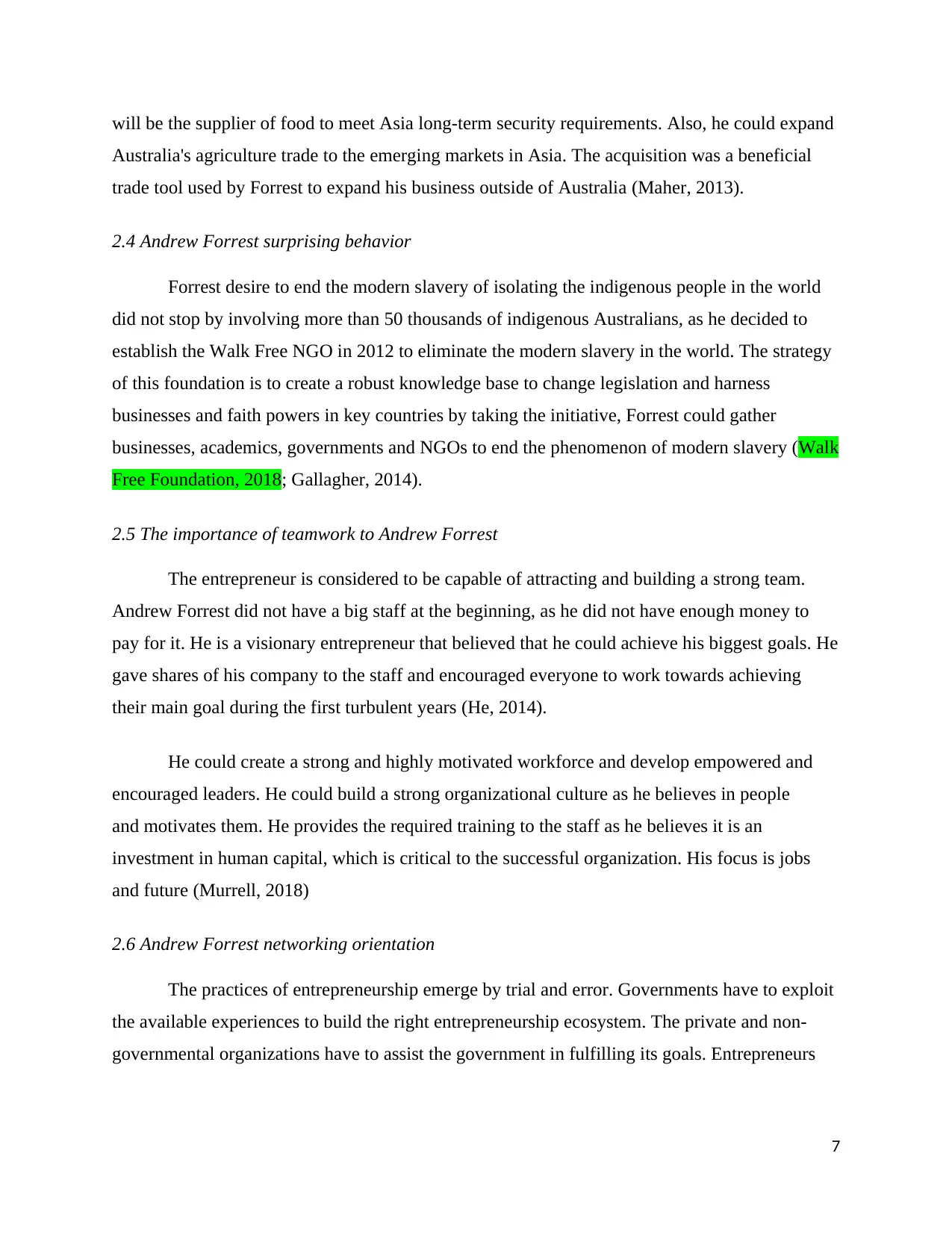
will be the supplier of food to meet Asia long-term security requirements. Also, he could expand
Australia's agriculture trade to the emerging markets in Asia. The acquisition was a beneficial
trade tool used by Forrest to expand his business outside of Australia (Maher, 2013).
2.4 Andrew Forrest surprising behavior
Forrest desire to end the modern slavery of isolating the indigenous people in the world
did not stop by involving more than 50 thousands of indigenous Australians, as he decided to
establish the Walk Free NGO in 2012 to eliminate the modern slavery in the world. The strategy
of this foundation is to create a robust knowledge base to change legislation and harness
businesses and faith powers in key countries by taking the initiative, Forrest could gather
businesses, academics, governments and NGOs to end the phenomenon of modern slavery (Walk
Free Foundation, 2018; Gallagher, 2014).
2.5 The importance of teamwork to Andrew Forrest
The entrepreneur is considered to be capable of attracting and building a strong team.
Andrew Forrest did not have a big staff at the beginning, as he did not have enough money to
pay for it. He is a visionary entrepreneur that believed that he could achieve his biggest goals. He
gave shares of his company to the staff and encouraged everyone to work towards achieving
their main goal during the first turbulent years (He, 2014).
He could create a strong and highly motivated workforce and develop empowered and
encouraged leaders. He could build a strong organizational culture as he believes in people
and motivates them. He provides the required training to the staff as he believes it is an
investment in human capital, which is critical to the successful organization. His focus is jobs
and future (Murrell, 2018)
2.6 Andrew Forrest networking orientation
The practices of entrepreneurship emerge by trial and error. Governments have to exploit
the available experiences to build the right entrepreneurship ecosystem. The private and non-
governmental organizations have to assist the government in fulfilling its goals. Entrepreneurs
7
Australia's agriculture trade to the emerging markets in Asia. The acquisition was a beneficial
trade tool used by Forrest to expand his business outside of Australia (Maher, 2013).
2.4 Andrew Forrest surprising behavior
Forrest desire to end the modern slavery of isolating the indigenous people in the world
did not stop by involving more than 50 thousands of indigenous Australians, as he decided to
establish the Walk Free NGO in 2012 to eliminate the modern slavery in the world. The strategy
of this foundation is to create a robust knowledge base to change legislation and harness
businesses and faith powers in key countries by taking the initiative, Forrest could gather
businesses, academics, governments and NGOs to end the phenomenon of modern slavery (Walk
Free Foundation, 2018; Gallagher, 2014).
2.5 The importance of teamwork to Andrew Forrest
The entrepreneur is considered to be capable of attracting and building a strong team.
Andrew Forrest did not have a big staff at the beginning, as he did not have enough money to
pay for it. He is a visionary entrepreneur that believed that he could achieve his biggest goals. He
gave shares of his company to the staff and encouraged everyone to work towards achieving
their main goal during the first turbulent years (He, 2014).
He could create a strong and highly motivated workforce and develop empowered and
encouraged leaders. He could build a strong organizational culture as he believes in people
and motivates them. He provides the required training to the staff as he believes it is an
investment in human capital, which is critical to the successful organization. His focus is jobs
and future (Murrell, 2018)
2.6 Andrew Forrest networking orientation
The practices of entrepreneurship emerge by trial and error. Governments have to exploit
the available experiences to build the right entrepreneurship ecosystem. The private and non-
governmental organizations have to assist the government in fulfilling its goals. Entrepreneurs
7
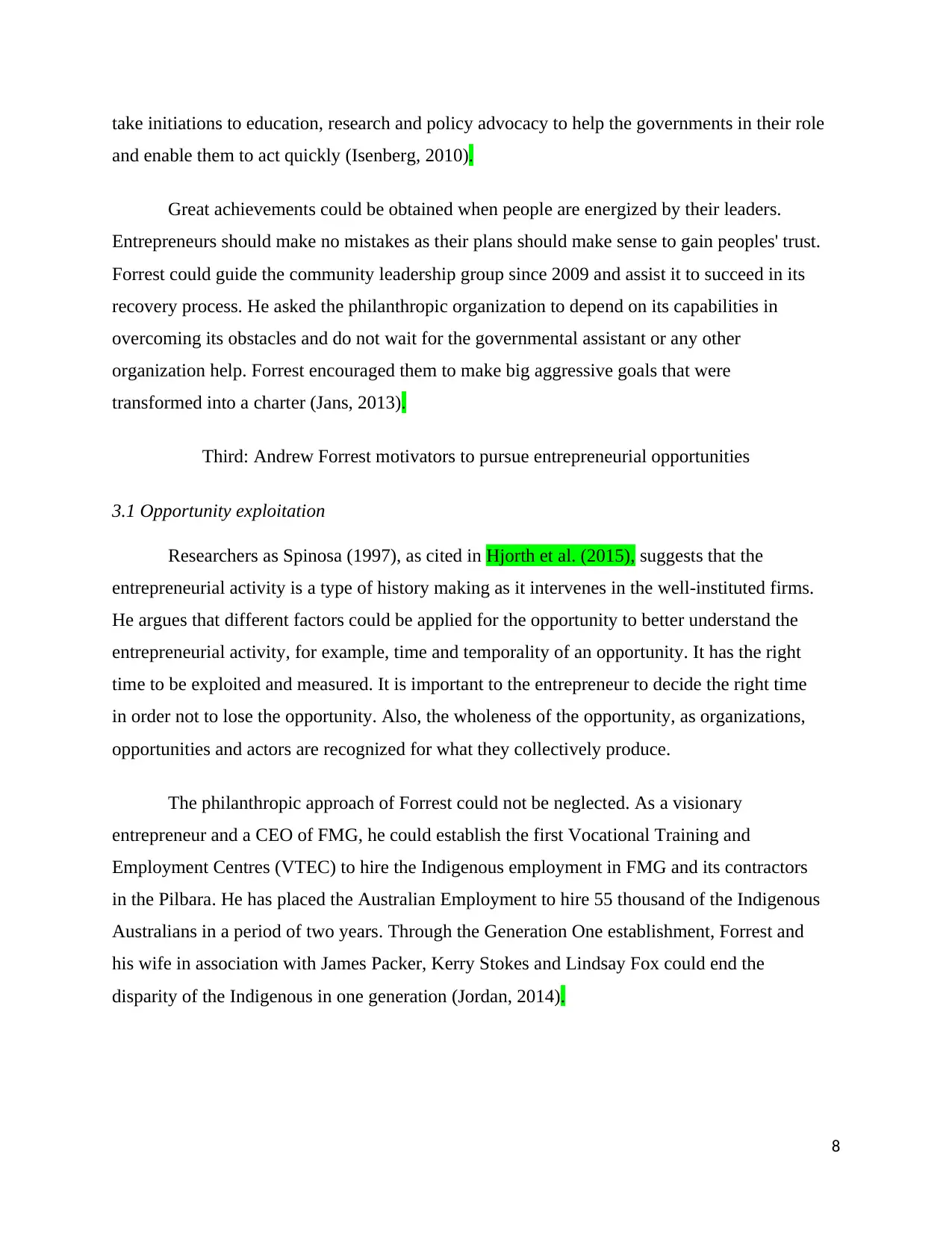
take initiations to education, research and policy advocacy to help the governments in their role
and enable them to act quickly (Isenberg, 2010).
Great achievements could be obtained when people are energized by their leaders.
Entrepreneurs should make no mistakes as their plans should make sense to gain peoples' trust.
Forrest could guide the community leadership group since 2009 and assist it to succeed in its
recovery process. He asked the philanthropic organization to depend on its capabilities in
overcoming its obstacles and do not wait for the governmental assistant or any other
organization help. Forrest encouraged them to make big aggressive goals that were
transformed into a charter (Jans, 2013).
Third: Andrew Forrest motivators to pursue entrepreneurial opportunities
3.1 Opportunity exploitation
Researchers as Spinosa (1997), as cited in Hjorth et al. (2015), suggests that the
entrepreneurial activity is a type of history making as it intervenes in the well-instituted firms.
He argues that different factors could be applied for the opportunity to better understand the
entrepreneurial activity, for example, time and temporality of an opportunity. It has the right
time to be exploited and measured. It is important to the entrepreneur to decide the right time
in order not to lose the opportunity. Also, the wholeness of the opportunity, as organizations,
opportunities and actors are recognized for what they collectively produce.
The philanthropic approach of Forrest could not be neglected. As a visionary
entrepreneur and a CEO of FMG, he could establish the first Vocational Training and
Employment Centres (VTEC) to hire the Indigenous employment in FMG and its contractors
in the Pilbara. He has placed the Australian Employment to hire 55 thousand of the Indigenous
Australians in a period of two years. Through the Generation One establishment, Forrest and
his wife in association with James Packer, Kerry Stokes and Lindsay Fox could end the
disparity of the Indigenous in one generation (Jordan, 2014).
8
and enable them to act quickly (Isenberg, 2010).
Great achievements could be obtained when people are energized by their leaders.
Entrepreneurs should make no mistakes as their plans should make sense to gain peoples' trust.
Forrest could guide the community leadership group since 2009 and assist it to succeed in its
recovery process. He asked the philanthropic organization to depend on its capabilities in
overcoming its obstacles and do not wait for the governmental assistant or any other
organization help. Forrest encouraged them to make big aggressive goals that were
transformed into a charter (Jans, 2013).
Third: Andrew Forrest motivators to pursue entrepreneurial opportunities
3.1 Opportunity exploitation
Researchers as Spinosa (1997), as cited in Hjorth et al. (2015), suggests that the
entrepreneurial activity is a type of history making as it intervenes in the well-instituted firms.
He argues that different factors could be applied for the opportunity to better understand the
entrepreneurial activity, for example, time and temporality of an opportunity. It has the right
time to be exploited and measured. It is important to the entrepreneur to decide the right time
in order not to lose the opportunity. Also, the wholeness of the opportunity, as organizations,
opportunities and actors are recognized for what they collectively produce.
The philanthropic approach of Forrest could not be neglected. As a visionary
entrepreneur and a CEO of FMG, he could establish the first Vocational Training and
Employment Centres (VTEC) to hire the Indigenous employment in FMG and its contractors
in the Pilbara. He has placed the Australian Employment to hire 55 thousand of the Indigenous
Australians in a period of two years. Through the Generation One establishment, Forrest and
his wife in association with James Packer, Kerry Stokes and Lindsay Fox could end the
disparity of the Indigenous in one generation (Jordan, 2014).
8

3.2 Hurdles Andrew Forrest could overcome
The framework of the 3E theory is based on positivist, epistemology and normal science
ontology. It argues that the process of entrepreneurship starts faces uncertain and resource-
restricted condition and decides to engage in the process. When the entrepreneur decides to
engage, the process reaches its end when it succeeds in artifact a new market (Garud & Gehman,
2016).
Forrest could overcome many obstacles, the major one is the governmental regulations
and red tape. Forrest is considered an outspoken critic of the governmental excessive regulation
and routine that negatively affect business in Western Australia's regional areas in addition to the
rent mining taxes imposed by the Federal Government that FMG is challenging in the High
Court on constitutional grounds (Weekly Farming, 2012).
Fourth: The reflection of this study on my knowledge of entrepreneurship
4.1 Personal reflection
This study blends the theory with practice, as it highlights the different entrepreneurial
approaches with an application on Andrew Forrest the mining magnet Australian entrepreneur. It
assisted in deepening my knowledge with the entrepreneurial orientation and its dimensions. The
three approaches to opportunity process increased my knowledge about the differences in the
types of entrepreneurs and their characteristics that enabled me to judge the entrepreneurship
style of Forrest. Analyzing the philanthropic orientation of Forrest enhanced my understanding
of the great role an entrepreneur can do with enhancing the social activities away from the
government.
4.2 Confirmed /contradicted issues revealed in the study of entrepreneurship
It is confirmed that Forrest is an innovative entrepreneur who seeks to exploit the
opportunities that assist him in achieving his greatest goals. Also, he is a high-risk taker, as he
could create big visions that nobody believed it could be achieved. On the other hand, the
literature on entrepreneurship argues that the entrepreneur seeks to maximize his profits and the
efficiency of their operations through utilizing their cash flows. But through the analysis of
9
The framework of the 3E theory is based on positivist, epistemology and normal science
ontology. It argues that the process of entrepreneurship starts faces uncertain and resource-
restricted condition and decides to engage in the process. When the entrepreneur decides to
engage, the process reaches its end when it succeeds in artifact a new market (Garud & Gehman,
2016).
Forrest could overcome many obstacles, the major one is the governmental regulations
and red tape. Forrest is considered an outspoken critic of the governmental excessive regulation
and routine that negatively affect business in Western Australia's regional areas in addition to the
rent mining taxes imposed by the Federal Government that FMG is challenging in the High
Court on constitutional grounds (Weekly Farming, 2012).
Fourth: The reflection of this study on my knowledge of entrepreneurship
4.1 Personal reflection
This study blends the theory with practice, as it highlights the different entrepreneurial
approaches with an application on Andrew Forrest the mining magnet Australian entrepreneur. It
assisted in deepening my knowledge with the entrepreneurial orientation and its dimensions. The
three approaches to opportunity process increased my knowledge about the differences in the
types of entrepreneurs and their characteristics that enabled me to judge the entrepreneurship
style of Forrest. Analyzing the philanthropic orientation of Forrest enhanced my understanding
of the great role an entrepreneur can do with enhancing the social activities away from the
government.
4.2 Confirmed /contradicted issues revealed in the study of entrepreneurship
It is confirmed that Forrest is an innovative entrepreneur who seeks to exploit the
opportunities that assist him in achieving his greatest goals. Also, he is a high-risk taker, as he
could create big visions that nobody believed it could be achieved. On the other hand, the
literature on entrepreneurship argues that the entrepreneur seeks to maximize his profits and the
efficiency of their operations through utilizing their cash flows. But through the analysis of
9
Secure Best Marks with AI Grader
Need help grading? Try our AI Grader for instant feedback on your assignments.

Forrest entrepreneurship orientation, it is obvious that creating a big wealth is not the unique goal
of an entrepreneur as the philanthropic activities that Forrest could do and its impact of
eliminating the new slavery is highly recognized and respected.
4.3 The new insights emerged from this study
It is possible to achieve big visions by taking a risk and making the right decisions at the
right time to exploit opportunities. Starting with a small team that is encouraged and involved in
the business as shareholders could make great achievements in the future and sustains the
business. Unlike other entrepreneurs who make an exit plan and sell their business at the end of
his life cycle as an entrepreneur, Forrest could maintain his business and become a billionaire
and among the richest businessmen in Australia.
Conclusions
There are three main approaches that describe the individual approaching new
opportunities, judge maker, discoverer and enacting. Forrest is considered a good observer of the
market to exploit the right opportunity is a discoverer entrepreneur. Kirzner described this type
of entrepreneurship as arbitrager that gathers information to discover. Fortescue could become a
new force in iron ore in a short period of time and expand the company scale with about tenfold.
EO is a behavior that gives meaning to the entrepreneurial process rather than an
attribute. EO involves major three aspects of an entrepreneur represented in innovation, risk
taking and introduction of new products and services to the customers.
The entrepreneurial process gains its meaning from the behavior of the entrepreneur as
the action of the entrepreneur is the indication of his existence. The entrepreneurial activity is a
type of history making as it intervenes in the well-instituted firms. It is important to the
entrepreneur to decide the right time in order not to lose the opportunity. Forrest desire to end the
modern slavery of isolating the indigenous people in the world did not stop by involving more
than 50 thousands of indigenous Australians, as he decided to establish the Walk Free NGO in
2012 to eliminate the modern slavery in the world.
10
of an entrepreneur as the philanthropic activities that Forrest could do and its impact of
eliminating the new slavery is highly recognized and respected.
4.3 The new insights emerged from this study
It is possible to achieve big visions by taking a risk and making the right decisions at the
right time to exploit opportunities. Starting with a small team that is encouraged and involved in
the business as shareholders could make great achievements in the future and sustains the
business. Unlike other entrepreneurs who make an exit plan and sell their business at the end of
his life cycle as an entrepreneur, Forrest could maintain his business and become a billionaire
and among the richest businessmen in Australia.
Conclusions
There are three main approaches that describe the individual approaching new
opportunities, judge maker, discoverer and enacting. Forrest is considered a good observer of the
market to exploit the right opportunity is a discoverer entrepreneur. Kirzner described this type
of entrepreneurship as arbitrager that gathers information to discover. Fortescue could become a
new force in iron ore in a short period of time and expand the company scale with about tenfold.
EO is a behavior that gives meaning to the entrepreneurial process rather than an
attribute. EO involves major three aspects of an entrepreneur represented in innovation, risk
taking and introduction of new products and services to the customers.
The entrepreneurial process gains its meaning from the behavior of the entrepreneur as
the action of the entrepreneur is the indication of his existence. The entrepreneurial activity is a
type of history making as it intervenes in the well-instituted firms. It is important to the
entrepreneur to decide the right time in order not to lose the opportunity. Forrest desire to end the
modern slavery of isolating the indigenous people in the world did not stop by involving more
than 50 thousands of indigenous Australians, as he decided to establish the Walk Free NGO in
2012 to eliminate the modern slavery in the world.
10
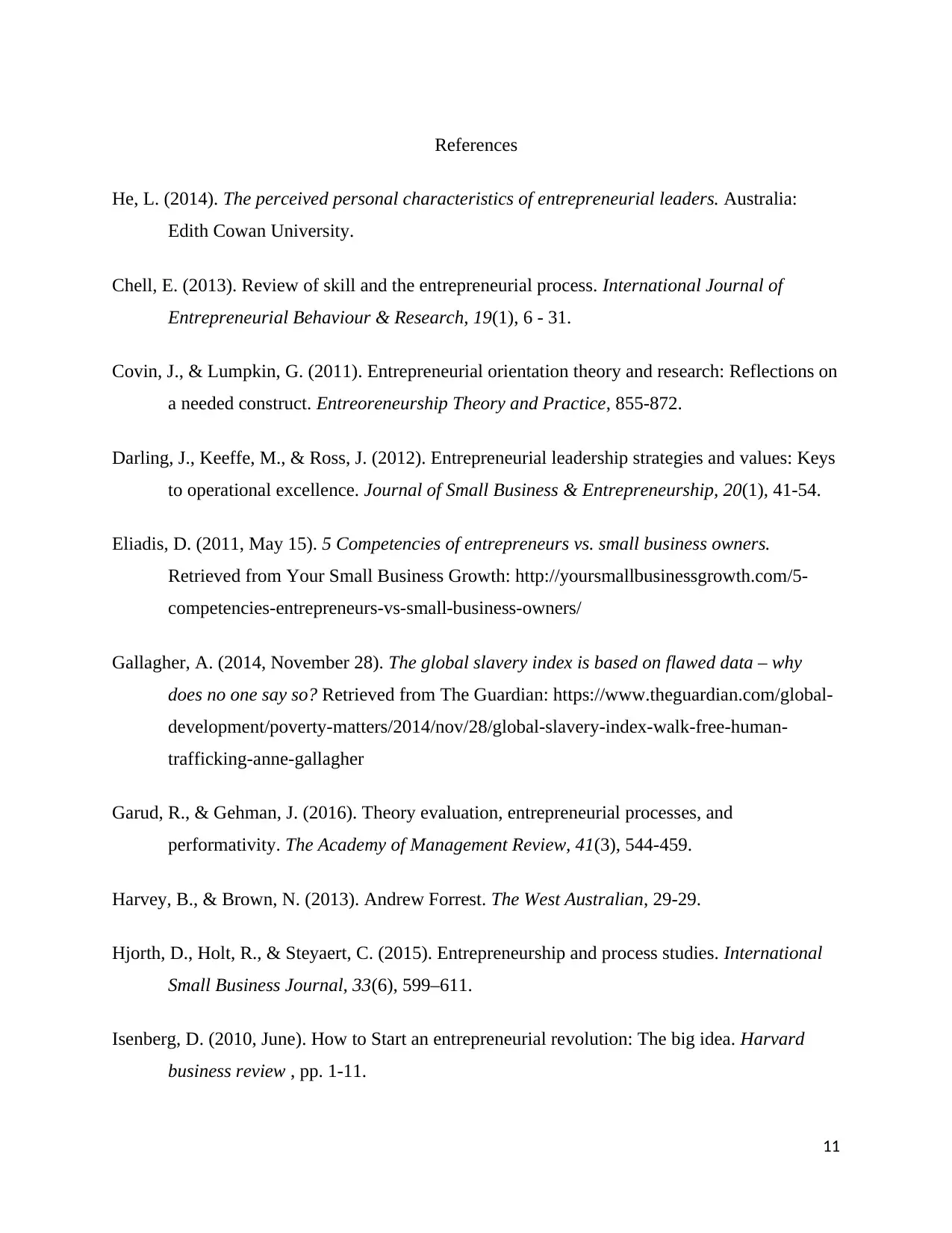
References
He, L. (2014). The perceived personal characteristics of entrepreneurial leaders. Australia:
Edith Cowan University.
Chell, E. (2013). Review of skill and the entrepreneurial process. International Journal of
Entrepreneurial Behaviour & Research, 19(1), 6 - 31.
Covin, J., & Lumpkin, G. (2011). Entrepreneurial orientation theory and research: Reflections on
a needed construct. Entreoreneurship Theory and Practice, 855-872.
Darling, J., Keeffe, M., & Ross, J. (2012). Entrepreneurial leadership strategies and values: Keys
to operational excellence. Journal of Small Business & Entrepreneurship, 20(1), 41-54.
Eliadis, D. (2011, May 15). 5 Competencies of entrepreneurs vs. small business owners.
Retrieved from Your Small Business Growth: http://yoursmallbusinessgrowth.com/5-
competencies-entrepreneurs-vs-small-business-owners/
Gallagher, A. (2014, November 28). The global slavery index is based on flawed data – why
does no one say so? Retrieved from The Guardian: https://www.theguardian.com/global-
development/poverty-matters/2014/nov/28/global-slavery-index-walk-free-human-
trafficking-anne-gallagher
Garud, R., & Gehman, J. (2016). Theory evaluation, entrepreneurial processes, and
performativity. The Academy of Management Review, 41(3), 544-459.
Harvey, B., & Brown, N. (2013). Andrew Forrest. The West Australian, 29-29.
Hjorth, D., Holt, R., & Steyaert, C. (2015). Entrepreneurship and process studies. International
Small Business Journal, 33(6), 599–611.
Isenberg, D. (2010, June). How to Start an entrepreneurial revolution: The big idea. Harvard
business review , pp. 1-11.
11
He, L. (2014). The perceived personal characteristics of entrepreneurial leaders. Australia:
Edith Cowan University.
Chell, E. (2013). Review of skill and the entrepreneurial process. International Journal of
Entrepreneurial Behaviour & Research, 19(1), 6 - 31.
Covin, J., & Lumpkin, G. (2011). Entrepreneurial orientation theory and research: Reflections on
a needed construct. Entreoreneurship Theory and Practice, 855-872.
Darling, J., Keeffe, M., & Ross, J. (2012). Entrepreneurial leadership strategies and values: Keys
to operational excellence. Journal of Small Business & Entrepreneurship, 20(1), 41-54.
Eliadis, D. (2011, May 15). 5 Competencies of entrepreneurs vs. small business owners.
Retrieved from Your Small Business Growth: http://yoursmallbusinessgrowth.com/5-
competencies-entrepreneurs-vs-small-business-owners/
Gallagher, A. (2014, November 28). The global slavery index is based on flawed data – why
does no one say so? Retrieved from The Guardian: https://www.theguardian.com/global-
development/poverty-matters/2014/nov/28/global-slavery-index-walk-free-human-
trafficking-anne-gallagher
Garud, R., & Gehman, J. (2016). Theory evaluation, entrepreneurial processes, and
performativity. The Academy of Management Review, 41(3), 544-459.
Harvey, B., & Brown, N. (2013). Andrew Forrest. The West Australian, 29-29.
Hjorth, D., Holt, R., & Steyaert, C. (2015). Entrepreneurship and process studies. International
Small Business Journal, 33(6), 599–611.
Isenberg, D. (2010, June). How to Start an entrepreneurial revolution: The big idea. Harvard
business review , pp. 1-11.
11
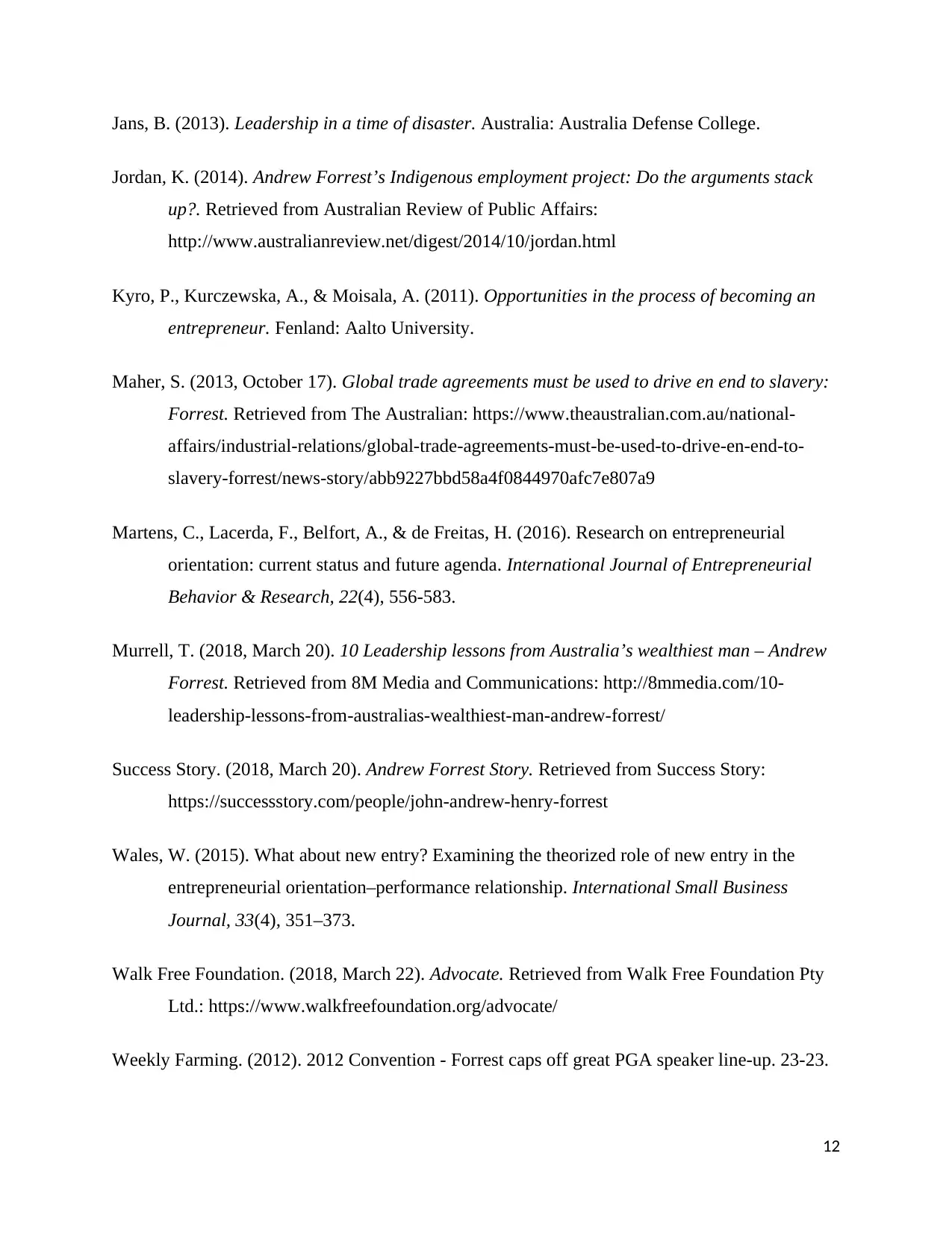
Jans, B. (2013). Leadership in a time of disaster. Australia: Australia Defense College.
Jordan, K. (2014). Andrew Forrest’s Indigenous employment project: Do the arguments stack
up?. Retrieved from Australian Review of Public Affairs:
http://www.australianreview.net/digest/2014/10/jordan.html
Kyro, P., Kurczewska, A., & Moisala, A. (2011). Opportunities in the process of becoming an
entrepreneur. Fenland: Aalto University.
Maher, S. (2013, October 17). Global trade agreements must be used to drive en end to slavery:
Forrest. Retrieved from The Australian: https://www.theaustralian.com.au/national-
affairs/industrial-relations/global-trade-agreements-must-be-used-to-drive-en-end-to-
slavery-forrest/news-story/abb9227bbd58a4f0844970afc7e807a9
Martens, C., Lacerda, F., Belfort, A., & de Freitas, H. (2016). Research on entrepreneurial
orientation: current status and future agenda. International Journal of Entrepreneurial
Behavior & Research, 22(4), 556-583.
Murrell, T. (2018, March 20). 10 Leadership lessons from Australia’s wealthiest man – Andrew
Forrest. Retrieved from 8M Media and Communications: http://8mmedia.com/10-
leadership-lessons-from-australias-wealthiest-man-andrew-forrest/
Success Story. (2018, March 20). Andrew Forrest Story. Retrieved from Success Story:
https://successstory.com/people/john-andrew-henry-forrest
Wales, W. (2015). What about new entry? Examining the theorized role of new entry in the
entrepreneurial orientation–performance relationship. International Small Business
Journal, 33(4), 351–373.
Walk Free Foundation. (2018, March 22). Advocate. Retrieved from Walk Free Foundation Pty
Ltd.: https://www.walkfreefoundation.org/advocate/
Weekly Farming. (2012). 2012 Convention - Forrest caps off great PGA speaker line-up. 23-23.
12
Jordan, K. (2014). Andrew Forrest’s Indigenous employment project: Do the arguments stack
up?. Retrieved from Australian Review of Public Affairs:
http://www.australianreview.net/digest/2014/10/jordan.html
Kyro, P., Kurczewska, A., & Moisala, A. (2011). Opportunities in the process of becoming an
entrepreneur. Fenland: Aalto University.
Maher, S. (2013, October 17). Global trade agreements must be used to drive en end to slavery:
Forrest. Retrieved from The Australian: https://www.theaustralian.com.au/national-
affairs/industrial-relations/global-trade-agreements-must-be-used-to-drive-en-end-to-
slavery-forrest/news-story/abb9227bbd58a4f0844970afc7e807a9
Martens, C., Lacerda, F., Belfort, A., & de Freitas, H. (2016). Research on entrepreneurial
orientation: current status and future agenda. International Journal of Entrepreneurial
Behavior & Research, 22(4), 556-583.
Murrell, T. (2018, March 20). 10 Leadership lessons from Australia’s wealthiest man – Andrew
Forrest. Retrieved from 8M Media and Communications: http://8mmedia.com/10-
leadership-lessons-from-australias-wealthiest-man-andrew-forrest/
Success Story. (2018, March 20). Andrew Forrest Story. Retrieved from Success Story:
https://successstory.com/people/john-andrew-henry-forrest
Wales, W. (2015). What about new entry? Examining the theorized role of new entry in the
entrepreneurial orientation–performance relationship. International Small Business
Journal, 33(4), 351–373.
Walk Free Foundation. (2018, March 22). Advocate. Retrieved from Walk Free Foundation Pty
Ltd.: https://www.walkfreefoundation.org/advocate/
Weekly Farming. (2012). 2012 Convention - Forrest caps off great PGA speaker line-up. 23-23.
12
Paraphrase This Document
Need a fresh take? Get an instant paraphrase of this document with our AI Paraphraser
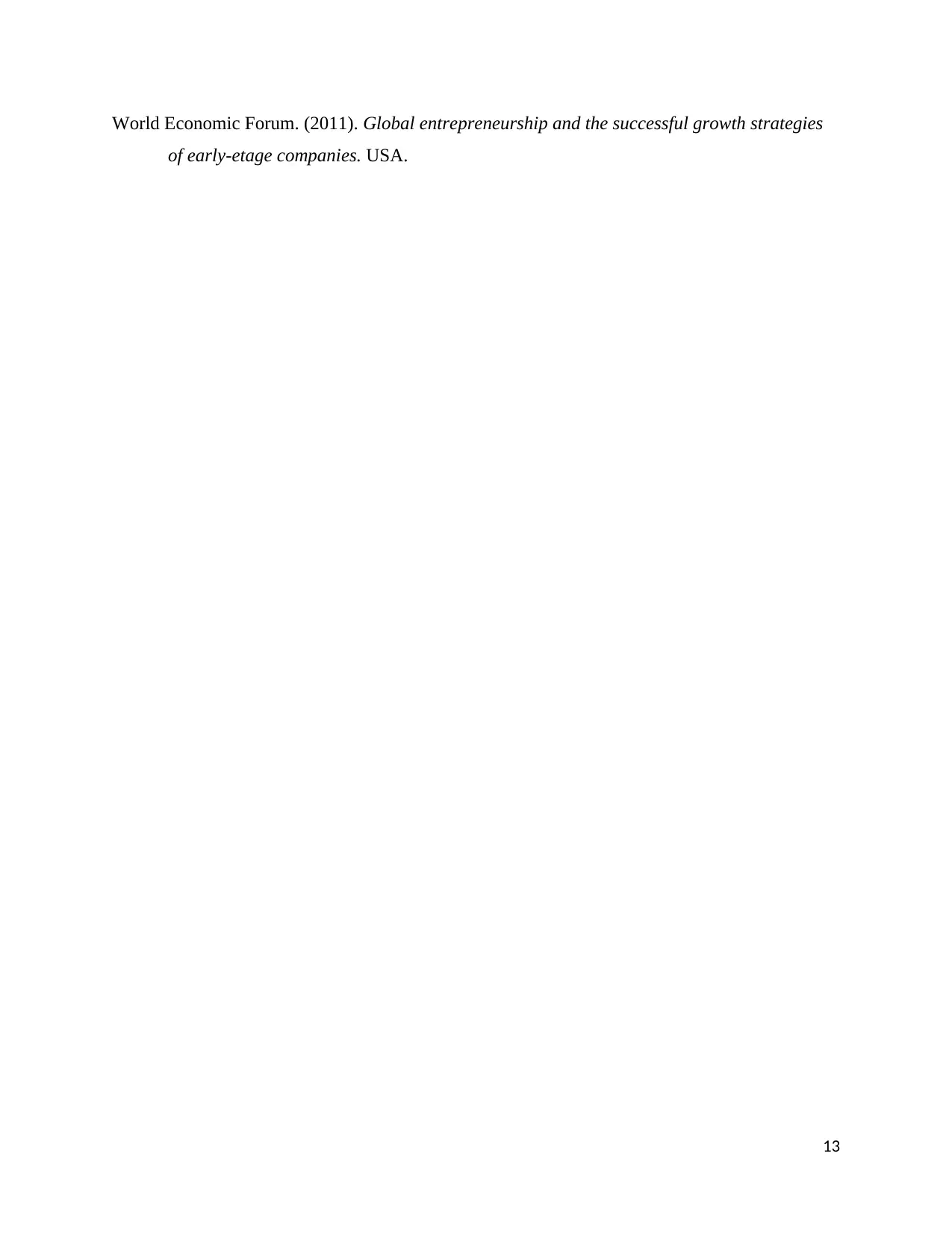
World Economic Forum. (2011). Global entrepreneurship and the successful growth strategies
of early-etage companies. USA.
13
of early-etage companies. USA.
13
1 out of 14
Your All-in-One AI-Powered Toolkit for Academic Success.
+13062052269
info@desklib.com
Available 24*7 on WhatsApp / Email
![[object Object]](/_next/static/media/star-bottom.7253800d.svg)
Unlock your academic potential
© 2024 | Zucol Services PVT LTD | All rights reserved.

